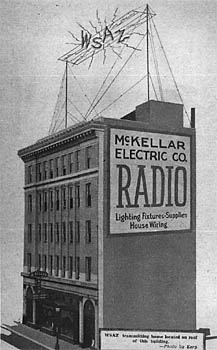
After a sputtering start in Ohio, WSAZ radio came to Huntington in 1926, when it was purchased by W.C. McKellar (inset) who operated the station out of his electrical supply store on Fourth Avenue. The transmitter was on the roof of the building and a live-performance studio was placed in the store's front window. Photographs from about 1927, courtesy of the Museum of Radio and Technology and George Andrick.
WSAZ Radio
"The Worst Station from A to Z"
By Corley F. Dennison
Huntington's first radio station started its life in Ohio. Despite financial and technical problems, WSAZ radio began a semi-regular schedule of broadcasts in the small Ohio River town of Pomeroy, in October 1923. WSAZ had been such a headache to radio engineer Glenn Chase that he claimed to have selected the call letters WSAZ to stand for the "Worst Station from A to Z." According to Chase, "Even a loud voice could put the station off the air."
There is some debate as to what the letters WSAZ actually represent. Station call letters were assigned sequentially by the Department of Commerce, and WSAZ came just after WSAX, Chicago and WSAY, Port Chester, New York. Some local historians believe that the call sign was sequentially assigned and that engineer Chase later applied the slogan. Others contend that Chase requested those letters to reflect his frustrations with the fledgling station.
The original license authorized WSAZ to operate on 1160 kilocycles with 50 watts of power. In late 1924, WSAZ was notified by the Commerce Department to change frequency to 1230 kilocycles.
Broadcasting hours were irregular and sponsors were few as the new station struggled to make ends meets. After more than two years of trying to make the station financially viable, Chase packed his bags and went looking for help 45 miles downriver in Huntington. Chase sold controlling interest in the station to a Huntington businessman named W.C. McKellar, and accepted the position of radio service manager for the McKellar Electric Company. McKellar wanted to use the radio station to promote the sales of radio sets at his Fourth Avenue store. So, Chase spent several months setting up the studio and transmission facilities and building a special live-performance studio in the store's front window.
Irregular broadcasts took place throughout the winter months of 1926 and early 1927. By April 1927, WSAZ was ready to take to the air with 100 watts of power and a daily broadcast schedule of four hours each evening except Sundays, now at 1240 on the dial.
Each hour had one sponsor at a cost of four dollars per hour, or $24 per week. Minter Homes, Kenny Music Company, Graves-Thornton Hardware, and Lamb & Love Electric and Hardware Company were to become loyal advertisers for many years on WSAZ.
You can read the rest of this article in the Winter 2001 issue of Goldenseal, available in bookstores, libraries or direct from Goldenseal.